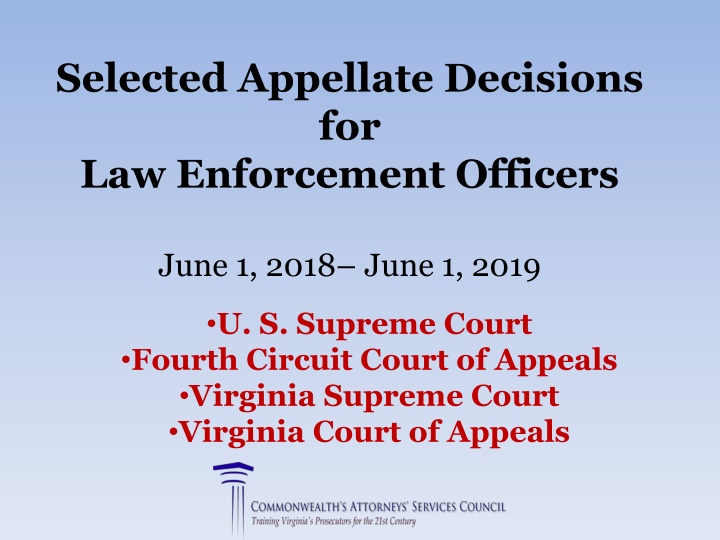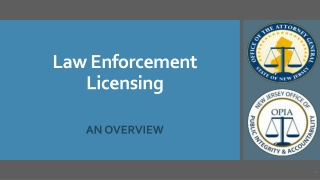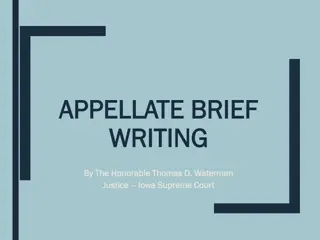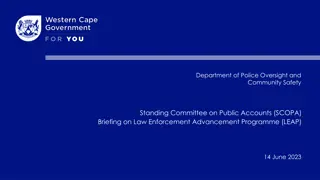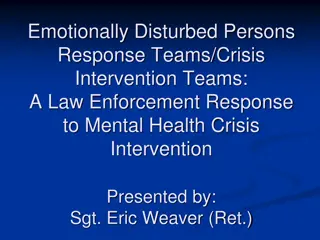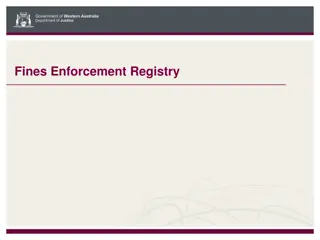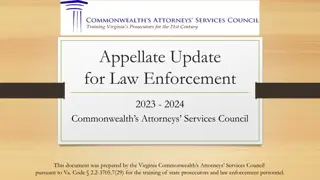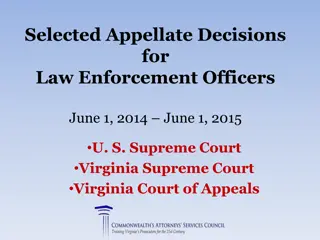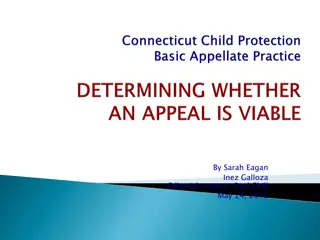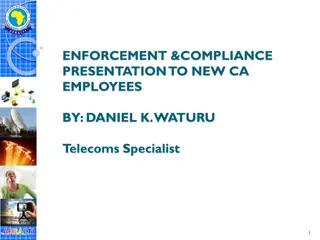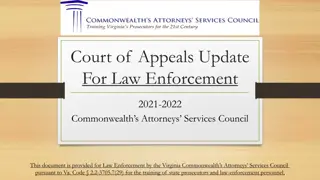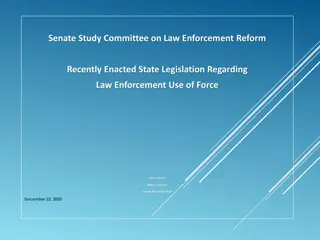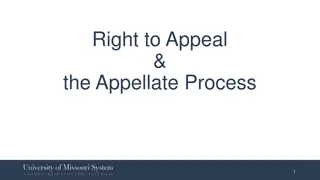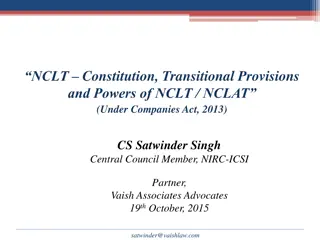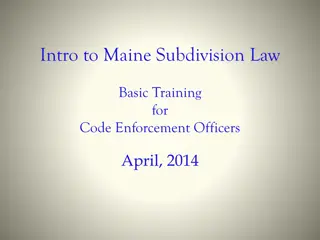Selected Appellate Decisions for Law Enforcement Officers Update
This update provides insights into significant appellate decisions relevant to law enforcement officers from June 1, 2018, to June 1, 2019, covering a range of topics including the Fifth and Fourth Amendments, crimes against persons and property, drug and gun offenses, traffic violations, and police use of force. It highlights key cases on interviews and interrogations, emphasizing the right to remain silent and custodial interrogation procedures based on recent court rulings.
Download Presentation

Please find below an Image/Link to download the presentation.
The content on the website is provided AS IS for your information and personal use only. It may not be sold, licensed, or shared on other websites without obtaining consent from the author.If you encounter any issues during the download, it is possible that the publisher has removed the file from their server.
You are allowed to download the files provided on this website for personal or commercial use, subject to the condition that they are used lawfully. All files are the property of their respective owners.
The content on the website is provided AS IS for your information and personal use only. It may not be sold, licensed, or shared on other websites without obtaining consent from the author.
E N D
Presentation Transcript
Selected Appellate Decisions for Law Enforcement Officers June 1, 2018 June 1, 2019 U. S. Supreme Court Fourth Circuit Court of Appeals Virginia Supreme Court Virginia Court of Appeals
Please refer to 2019 Appellate Update Master List for a complete listing of new cases of interest to law enforcement officers.
Topics for Presentation Fifth Amendment Fourth Amendment Crimes Against Persons Crimes Against Property Drug & Gun Offenses Traffic Offenses Police Use of Force
New Cases on Interviews & Interrogations FIFTH AMENDMENT
Right to Remain Silent Defendant in custody. When agents read Miranda warnings, defendant interrupted approximately halfway through to inform the officers that he wasn t going to say anything at all. Agents continued the Miranda warnings, defendant indicated he understood his rights, and defendant made a statement. Court: Statement suppressed. Defendant unambiguously invoked his right to remain silent, but nevertheless the officers continued interrogating him and thus failed to scrupulously honor the defendant s invocation. Once a suspect unambiguously invokes the right to remain silent, all questioning must cease. U.S. v. Abdallah, 4thCircuit December 2018
Right to Remain Silent Defendant in custody. After learning of his Miranda rights and making a few initial statements, the defendant stated: "I don't have no more to say to you." Court: Statement suppressed. Defendant s statement essentially meant: "I am invoking my right to remain silent. Context did not reasonably support any other interpretation, though in another context, it could have meant "I've told you everything I know about this subject, and there's no more for me to say about it." A suspect may invoke his right to remain silent and terminate questioning by simply stating "I do not want to answer any more questions." Adkins v. C/w, Va. Supreme Court March 28, 2019 (Unp.)
Custody & Law Enforcement Court: Defendant in prison was in custody for the purposes of Miranda when private contractor questioned him regarding ownership of contraband. Investigators do not have to provide Miranda warnings to all inmates, but here the seizure and transfer of the defendant was the functional equivalent of arrest. Defendant was subjected to additional and substantial restraints on his liberty, in addition to those he experienced every day as an inmate, thus the totality of the circumstances reasonably suggested a coercive environment & therefore Miranda is required. C/w v. Briggs, Ct. App. January 2019 (Unpublished)
New Cases on Search & Seizure FOURTH AMENDMENT
Search Warrant Required for Cell-Site Location Data Accessing seven days of historical cell-site location data is a Fourth Amendment search that normally requires a search warrant. Consent or exigent circumstances may still apply as exceptions to the warrant requirement. Court approvingly cited lower court opinions concerning bomb threats, active shootings, and child abductions Carpenter v. U.S., U.S. Supreme Court, June 22, 2018
Carpenter Lesson In any case where you are seeking historical cell- site location data, law enforcement officers should obtain a search warrant for that data. Although traditional Fourth Amendment exceptions, such as exigent circumstances, consent of the device s owner, etc., may still apply in individual cases, the default rule should be to get a warrant. Remember that 19.2-70.3(E)(5) requires you to file a written statement with the Clerk if you obtain real- time location data without a warrant in an emergency.
Inventory Searches Officer conducted inventory search of car because the car was being towed and that way we were not responsible for anything left in that vehicle. Government introduced no other testimony or documentary evidence regarding the Department s policy on inventory searches of cars. Court: Evidence suppressed. There must be sufficient evidence of inventory policy, whether through introduction of written police department rules and regulations or through police officer testimony. U.S. v. Young: 4thCircuit, October 25, 2018
Search Warrant Based on Marijuana Possession U.S. v. Lyles: 4thCir., December 14, 2018 Court suppressed a warrant for a house based on finding 3 marijuana stems and rolling papers during a single trash pull. Warrant sought evidence of possession of controlled substances, possession with intent to distribute controlled substances, and money laundering The miniscule quantity of marijuana detected in the trash pull, again, does not provide the requisite foundation to search any and all persons in the home, let alone any other location.
Scope of Warrant Warrant permitted the seizure of any computers, toiletries, or jewelry, and the search of every book, record, and document in the home Court: The connection of such things to the personal possession of marijuana is, to put it gently, tenuous. Court: Warrant application lacked any nexus between cell phones and marijuana possession. Insufficient reason to believe that any cell phone in the home, no matter who owns it, will reveal evidence pertinent to marijuana possession simply because three marijuana stems were found in a nearby trash bag.
31 Day Delay to Get Warrant U.S. v. Pratt: 4thCir., February 8, 2019 Defendant prostituted a child, trafficking her over state lines and producing child pornography by taking photos of her with his phone. When FBI agents arrested the defendant, he confessed that his phone had images of the victim on his phone. Agents seized the phone. However, agents did not obtain a warrant for the phone for another 31 days. After obtaining and executing the warrant, they discovered child pornography on the device.
Court: Evidence Suppressed Court: 31-day delay violates the Fourth Amendment where the government neither proceeds diligently nor presents an overriding reason for the delay. Court rejected the argument that the phone was, in and of itself, evidence and therefore could be held indefinitely because it had independent evidentiary value, like a murder weapon.
What Delays Are Permissible? Pratt Court distinguished a number of other cases where similar delays were lawful. For example, in Vallimont, delay was reasonable because the investigator was diverted to other cases, the county s resources were overwhelmed, and the defendant diminished his privacy interest by giving another person access to the computer. Also: Laist - delay was reasonable because the agents worked diligently on the affidavit; they were responsible for investigations in ten counties; and the defendant consented to the seizure and had been allowed to keep certain files, diminishing his privacy interest. Court also cited with approval delays due to weekends, holidays, tactical decisions, legal questions, and technical needs.
Exigent Circumstances Court: Exigent circumstances existed when officer saw a firearm in plain view on the floorboard of the vehicle from which the defendant had just fled, leaving the door open. Firearm was in the middle of the road where members of the crowd or the defendant, if he had returned to his vehicle, could immediately have accessed the loaded firearm. Court found that there was not sufficient time to secure a warrant as numerous people could have potentially obtained the firearm in the interim. Moore v. Commonwealth, 69 Va. App. 30 (2018)
K9 and Probable Cause K9 indicated that defendant, a passenger, possessed drugs during traffic stop, but officers could not find drugs during search on side of the road. Officers transported defendant to police facility where they found drugs. Court: Affirmed. Coupled with the evidence of the officer s training and experience, the history of the K-9 team, and the officer s testimony that the dog alerted consistent with her training, there was more than sufficient evidence to support the conclusion that the dog was reliable. Haywood v. Commonwealth, Ct. App., October 9, 2018 (Unp.)
Pat-Down v. Search Officer responded to a call for a larceny & saw defendant, who matched the description of the fleeing suspect, crouching down in the dark behind trucks in a parking lot adjacent to the store. Defendant fled & jumped into bushes when the officer was within an arm s length of him. Officer had to pull the defendant out of the bushes before he detained him. Officer patted-down the defendant and felt a round, cylindrical tube in the defendant s pocket. Officer removed it and found that it contained cocaine
Court: Suppressed Officer had a reasonable basis for frisking the defendant but lacked probable cause to remove the tube from his pocket. The plain feel doctrine applies only when the object at issue is immediately recognized as being illegal. Court complained that the officer did not say whether he suspected that the tube could be drug paraphernalia or that he suspected the object he felt was a weapon. Weathersby v. Commonwealth, Ct. App., October 9, 2018 (Unp.)
Warrantless Arrest in Curtilage Defendant led police on a high-speed chase on his motorcycle. 30-40 minutes later, officers identified defendant and located him at his home. They banged on his door and demanded he exit. Defendant stepped out onto driveway and officers arrested him. Court: Warrantless arrest suppressed. At the time of arrest, although they had probable cause, officers had no exigency. When he exited the house, defendant seemingly posed no threat to the officers, nor did he show any signs that he intended to flee, nor was there evidence to destroy. Carroll v. Commonwealth, Ct. App., November 20, 2018 (Unpublished)
PART TWO: CRIMES AND OFFENSES
Brutal Slaughter of Animal Sutter v. Commonwealth, Ct. App. September 26, 2018 (Unpublished) Defendant and her boyfriend took a pig from the ASPCA after hours without authority and stabbed it to death with over thirty-one stab wounds, nearly decapitating it. Court: Conviction affirmed. Killing was inconsistent with approved methods of slaughter.
Courts Explanation: Our holding in this particular case should not be interpreted in any way as somehow criminalizing the lawful conduct of the thousands of individuals (be they farmers, butchers, or otherwise) or businesses that routinely slaughter livestock, which they lawfully possess, in the normal course of their daily business. Rather, our opinion in this case bears specifically on the bizarre decision and conduct of appellant and her co-defendant, who decided to kill an animal which was not theirs in the yard and parking lot of the local SPCA and animal shelter, where appellant was then employed.
Forceful Attempt to Kiss Kelly v. Commonwealth, 9 Va. App. 617 (2019) Defendant convicted of Assault when he grabbed victim s face against her will while she was trying to pull away from him as she repeatedly told him, No. Court rejected his defense that he had implied consent to the touching because he and victim were coworkers and he did it in an effort to express his gratitude.
Aggravated Malicious Wounding Ellis v. Commonwealth, Ct. App., May 28, 2019 Defendant savagely attacked and killed his mother with his bare hands, and then with a hammer, while she was asleep. The medical examiner found that the victim had suffered numerous injuries that would have been fatal if inflicted in isolation. The victim suffered multiple contusions, which develop only while a victim remains alive. The trial court convicted the defendant of First Degree Murder and Aggravated Malicious Wounding.
Court: Affirmed Court: If, as in this case, it is established by the evidence and reasonable inferences therefrom that there was a temporal interval between the initial malicious wounding, with the victim remaining alive, and the subsequent death of the victim, then the defendant can be convicted of both aggravated malicious wounding and murder. Although the Court agreed that a victim must survive, if only briefly, for an injury to be considered permanent within the context of 18.2-51.2, in this case the evidence proved that the victim remained alive during intervals of the attack.
Child Drowning Caswell v. Commonwealth: Ct. App., July 24, 2018 (Unp.) Defendant, a babysitter, was aware that the older child knew how to unlock a sliding door in the house but could not swim without floatation devices and supervision. Children s mother asked defendant to secure a sliding door that led to the family s swimming pool. Defendant did not secure the door.
Conviction Affirmed for Allowing Child to Drown The evidence demonstrated that the defendant did not have contact with the children for about two hours, even though their playroom was visible from the kitchen, where she claimed she had been. Court: Leaving the sliding glass door in a playroom unsecure meant exposing the children to extreme danger, specifically the access to a five-foot-deep swimming pool that was just steps away from their playroom.
Solicitation by Text Message Commonwealth v. Murgia: May 16, 2019 Defendant sent 16-year-old track athlete sexually suggestive messages, including one in which he described in lengthy detail a dream in which he engaged in various sexual acts with the child. Defendant referred to the victim in text messages as yo sexy self and told her, I m gonna stretch your tight ass legs out and loosen them hips up, too. Court of Appeals reversed conviction for solicitation of a minor under 18.2-374.3(D).
Va. Supreme Court Reinstates Conviction Commonwealth was not required to prove that the defendant actually committed a crime of solicitation, only that he used a communications system for the purpose of soliciting the act. Intent may be inferred from the words alone used by the accused. Defendant used a communications system for the purpose of soliciting the victim to commit sexual acts proscribed by Code 18.2-374.3(D).
Accommodation is a Prior Conviction Jones v. Commonwealth: 69 Va. App. 582 (2018) Court: Any prior conviction of an offense under 18.2-248, including a conviction as an accommodation under 18.2-248(D), triggers the enhanced punishment provisions of 18.2-248(C). Accommodation language in 18.2-248(D) is a partial affirmative defense to mitigate the punishment for the crime of distribution of a controlled substance; however, it is not a separate offense requiring that the Commonwealth prove different elements.
Drug Conspiracy Lavalliere v. Commonwealth, Ct. App., April 9, 2019 (Unpublished) Defendant purchased large quantities of heroin between fifteen and thirty times from his source. He also purchased it, even when he bought larger amounts, at the same rate, and did not negotiate or receive a discount. At trial, his source testified that the defendant was one of his best customers and that he felt bad about always charging the same rate. He also alerted the defendant when a batch of heroin was possibly subpar.
Conspiracy Conviction Affirmed The existence of a chain of commerce does not, in and of itself, constitute a conspiracy solely because the goods sold, and re-sold, are illegal. Given that the source had an interest in defendant s re-distribution and that he continued to supply defendant, who was only able to be such a valuable customer because he was reselling, Court found that the evidence was sufficient to show that the source furthered, promoted or cooperated in defendant s redistribution.
EXTORTION & HUMAN TRAFFICKING
Human Trafficking Carr v. Commonwealth, 69 Va. App. 106 (2018) Defendants forced the victim to return under duress to hotel to resume prostitution after she tried to escape. Abduction conviction affirmed. Victim s eventual escape from that hotel did not override the fact that the defendant intended to deprive the victim of her personal liberty at the time he forced her to return.
Sex Trafficking Conviction Under 18.2-357.1 Affirmed Court: Sex-trafficking statute does not require force or coercion. Defendant s involvement in the victim s return to the hotel to resume prostitution, and the payment of his hotel room from her prostitution earnings, were sufficient to prove the defendant s guilt. The Court rejected the defendant s argument that the victim was a willing participant who engaged in prostitution to support her heroin habit and acquire money to obtain a better life.
Sex Trafficking under 18.2-357.1 Johnson v. Commonwealth, 69 Va.App. 639 (2019) Court: 18.2-357.1(A) (Pandering) does not require the element of force, intimidation, or the threat of force or violence, although subsection (B) does. The fact one of the women was engaged in prostitution before she met the defendant and continued to engage in prostitution after he was incarcerated did not change the fact that he solicited, invited, recruited, encouraged or otherwise caused her to engage in prostitution after she met him. Statute does not require the accused to have been the sole cause or the original cause for the person to engage in prostitution.
Robbery & Extortion Livingston v. Commonwealth, Ct. App., June 5, 2018 (Unp.) Defendants threatened the victim at his residence, demanding money. One showed the victim a firearm and said he was going to have to take blood. Defendant said, Let s smoke him now. We have enough room in the trunk. Let s do it right now. Victim took them to an ATM and gave them cash. Victim testified that he felt helpless because he was afraid he would be shot if he tried to run away.
Court: Conviction Affirmed Court held that the evidence was sufficient to prove that the defendant was guilty of abduction for pecuniary gain. Court found that the threat to smoke the victim, coupled with the co-defendant s threat and display of a handgun in his waistband, were intended to collect the debt by intimidating the victim.
Shooting at an Occupied Vehicle Jones v. Commonwealth: 821 S.E.2d 540 (2018) Defendant, while inside a vehicle, shot another person who was also inside the vehicle. Va. Supreme Court ruled that the statute does not require that the shooter be located outside of the vehicle when he fired shots at an occupied vehicle.
Use of a Firearm in Robbery Barney v. Commonwealth, 69 Va. App. 604 (2019) Defendant committed two robberies. During the robberies, defendant made statements and gestures to imply that she had a firearm. Her co-conspirator kept his hand in his pocket and told the clerk not to move and won t nobody get hurt. Defendant gave the clerk at the first robbery a note that said the clerk should give them the money and not make a sound if she wanted to live. At the second robbery, defendant told the clerk she had two guns facing her, and if the clerk went any slower that she was going to shoot her.
Court: Evidence Sufficient Court agreed that evidence was sufficient that, because the defendant said she had a gun in the second robbery, she used one at the first robbery, even though no firearm or facsimile of a firearm was ever seen or recovered. Note: Conviction reversed on jury instruction error.
Use of Firearm as Accessory Harris v. Commonwealth, Ct. App., October 9, 2018 (Unpublished) Defendant and his confederate robbed the victim at gunpoint while she was at home. Throughout the robbery, the defendant s confederate held a shotgun and pointed it at the victim. The defendant never handled any firearm. As they fled, the defendant told his confederate to shoot into the house. Court: Defendant, who was acting in concert with his confederate, was guilty as a principal in the second degree of possessing and using the firearm used by his accomplice.
